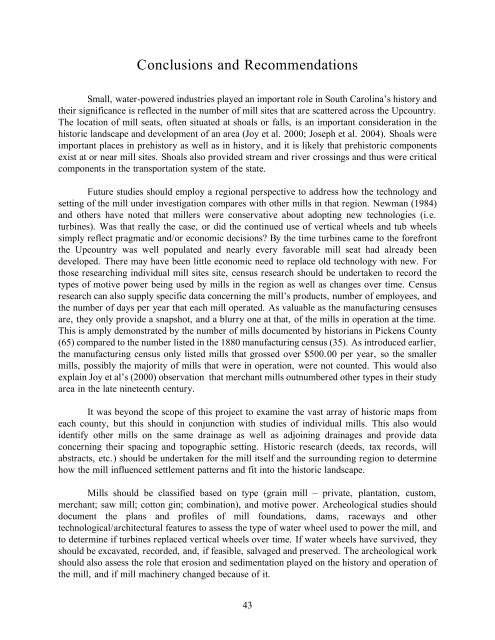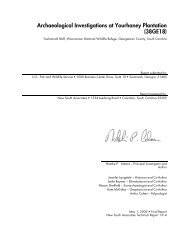Mills in the Upcountry: a Historic Context, and a Summary of a Mill ...
Mills in the Upcountry: a Historic Context, and a Summary of a Mill ...
Mills in the Upcountry: a Historic Context, and a Summary of a Mill ...
You also want an ePaper? Increase the reach of your titles
YUMPU automatically turns print PDFs into web optimized ePapers that Google loves.
Conclusions <strong>and</strong> Recommendations<br />
Small, water-powered <strong>in</strong>dustries played an important role <strong>in</strong> South Carol<strong>in</strong>a’s history <strong>and</strong><br />
<strong>the</strong>ir significance is reflected <strong>in</strong> <strong>the</strong> number <strong>of</strong> mill sites that are scattered across <strong>the</strong> <strong>Upcountry</strong>.<br />
The location <strong>of</strong> mill seats, <strong>of</strong>ten situated at shoals or falls, is an important consideration <strong>in</strong> <strong>the</strong><br />
historic l<strong>and</strong>scape <strong>and</strong> development <strong>of</strong> an area (Joy et al. 2000; Joseph et al. 2004). Shoals were<br />
important places <strong>in</strong> prehistory as well as <strong>in</strong> history, <strong>and</strong> it is likely that prehistoric components<br />
exist at or near mill sites. Shoals also provided stream <strong>and</strong> river cross<strong>in</strong>gs <strong>and</strong> thus were critical<br />
components <strong>in</strong> <strong>the</strong> transportation system <strong>of</strong> <strong>the</strong> state.<br />
Future studies should employ a regional perspective to address how <strong>the</strong> technology <strong>and</strong><br />
sett<strong>in</strong>g <strong>of</strong> <strong>the</strong> mill under <strong>in</strong>vestigation compares with o<strong>the</strong>r mills <strong>in</strong> that region. Newman (1984)<br />
<strong>and</strong> o<strong>the</strong>rs have noted that millers were conservative about adopt<strong>in</strong>g new technologies (i.e.<br />
turb<strong>in</strong>es). Was that really <strong>the</strong> case, or did <strong>the</strong> cont<strong>in</strong>ued use <strong>of</strong> vertical wheels <strong>and</strong> tub wheels<br />
simply reflect pragmatic <strong>and</strong>/or economic decisions? By <strong>the</strong> time turb<strong>in</strong>es came to <strong>the</strong> forefront<br />
<strong>the</strong> <strong>Upcountry</strong> was well populated <strong>and</strong> nearly every favorable mill seat had already been<br />
developed. There may have been little economic need to replace old technology with new. For<br />
those research<strong>in</strong>g <strong>in</strong>dividual mill sites site, census research should be undertaken to record <strong>the</strong><br />
types <strong>of</strong> motive power be<strong>in</strong>g used by mills <strong>in</strong> <strong>the</strong> region as well as changes over time. Census<br />
research can also supply specific data concern<strong>in</strong>g <strong>the</strong> mill’s products, number <strong>of</strong> employees, <strong>and</strong><br />
<strong>the</strong> number <strong>of</strong> days per year that each mill operated. As valuable as <strong>the</strong> manufactur<strong>in</strong>g censuses<br />
are, <strong>the</strong>y only provide a snapshot, <strong>and</strong> a blurry one at that, <strong>of</strong> <strong>the</strong> mills <strong>in</strong> operation at <strong>the</strong> time.<br />
This is amply demonstrated by <strong>the</strong> number <strong>of</strong> mills documented by historians <strong>in</strong> Pickens County<br />
(65) compared to <strong>the</strong> number listed <strong>in</strong> <strong>the</strong> 1880 manufactur<strong>in</strong>g census (35). As <strong>in</strong>troduced earlier,<br />
<strong>the</strong> manufactur<strong>in</strong>g census only listed mills that grossed over $500.00 per year, so <strong>the</strong> smaller<br />
mills, possibly <strong>the</strong> majority <strong>of</strong> mills that were <strong>in</strong> operation, were not counted. This would also<br />
expla<strong>in</strong> Joy et al’s (2000) observation that merchant mills outnumbered o<strong>the</strong>r types <strong>in</strong> <strong>the</strong>ir study<br />
area <strong>in</strong> <strong>the</strong> late n<strong>in</strong>eteenth century.<br />
It was beyond <strong>the</strong> scope <strong>of</strong> this project to exam<strong>in</strong>e <strong>the</strong> vast array <strong>of</strong> historic maps from<br />
each county, but this should <strong>in</strong> conjunction with studies <strong>of</strong> <strong>in</strong>dividual mills. This also would<br />
identify o<strong>the</strong>r mills on <strong>the</strong> same dra<strong>in</strong>age as well as adjo<strong>in</strong><strong>in</strong>g dra<strong>in</strong>ages <strong>and</strong> provide data<br />
concern<strong>in</strong>g <strong>the</strong>ir spac<strong>in</strong>g <strong>and</strong> topographic sett<strong>in</strong>g. <strong>Historic</strong> research (deeds, tax records, will<br />
abstracts, etc.) should be undertaken for <strong>the</strong> mill itself <strong>and</strong> <strong>the</strong> surround<strong>in</strong>g region to determ<strong>in</strong>e<br />
how <strong>the</strong> mill <strong>in</strong>fluenced settlement patterns <strong>and</strong> fit <strong>in</strong>to <strong>the</strong> historic l<strong>and</strong>scape.<br />
<strong><strong>Mill</strong>s</strong> should be classified based on type (gra<strong>in</strong> mill – private, plantation, custom,<br />
merchant; saw mill; cotton g<strong>in</strong>; comb<strong>in</strong>ation), <strong>and</strong> motive power. Archeological studies should<br />
document <strong>the</strong> plans <strong>and</strong> pr<strong>of</strong>iles <strong>of</strong> mill foundations, dams, raceways <strong>and</strong> o<strong>the</strong>r<br />
technological/architectural features to assess <strong>the</strong> type <strong>of</strong> water wheel used to power <strong>the</strong> mill, <strong>and</strong><br />
to determ<strong>in</strong>e if turb<strong>in</strong>es replaced vertical wheels over time. If water wheels have survived, <strong>the</strong>y<br />
should be excavated, recorded, <strong>and</strong>, if feasible, salvaged <strong>and</strong> preserved. The archeological work<br />
should also assess <strong>the</strong> role that erosion <strong>and</strong> sedimentation played on <strong>the</strong> history <strong>and</strong> operation <strong>of</strong><br />
<strong>the</strong> mill, <strong>and</strong> if mill mach<strong>in</strong>ery changed because <strong>of</strong> it.<br />
43







